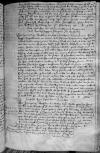Den ersamen, unsernn liebenn, getreuenn burgermeister und radtmann unser stadt ⌊Braunsberg⌋, unsern genedigenn willen.
Uns ist glaubwirdig vorkomenn, / davon uns auch ⌊f(urstliche) d(urchlauch)t⌋ ⌊⌋, / wie etzliche unser underthann, ewer mitburger, / so wol bei uns, als ihm furstentumb, / vorkeufe und boredung mit flachse, hoppenn und anderer whare / auf dorferenn und in stedtenn / mit dem gemeinem pauersman machenn, / zu schaden und vorfangen widder unser landsordnung, / anderen unseren stedten und dem hantirenden kaufmann, / und solche vorkeuffe wunderlicher weise durchtreibenn, / die whare der gestalt botriglichenn {betriglichen} zu sich gebracht, / durch vorkeuffer / unsere paurenn biss ghenn ⌊Braunsberg⌋, / auch weiter, sich lassenn zufhurenn, / welche unsere untreue underthan / die mussenn sein, / die bei euch widder unser landsordnung schreienn, / und andere dawidder anhetzen, / die wir, so wir die werden wissenn, mit ernster straf / als widderwertige und vorechter unser obricheit, / biss an ihr hochste zuforfurderenn durch unsere amptleute / nicht wollen noch lossenn[1], / darzu sondernn fleis zuhabenn, uns solche anzugeben, wan ihr die erfharet, / wir euch ernstlich bovelen, / ouch an AAWO, AB, A 2, f. 61rdere darzu vorordnenn wollenn, / die auf solche mutwillige und widder ihren eidt untreue, ungehorsame underthan / gutte achtung werden habenn, uns anzuzeigenn. / Derwegen lossen wir durch euch diese unser endtliche meinung idermenniglich ankundigenn. / Wirdt imands bei uns ader ihm ⌊furstentumb⌋, / wie solchs auch ⌊f(urs)t(liche) d(urchlauch)t⌋ von uns bogeret, / ihn solchenn stuckenn botroffenn, / des sol nicht vorschonet, / auch ihm keine genade bowesen werden. / Darnach habe sich ein ider zurichtenn.
AAWO, AB, A 2, f. 61rdere darzu vorordnenn wollenn, / die auf solche mutwillige und widder ihren eidt untreue, ungehorsame underthan / gutte achtung werden habenn, uns anzuzeigenn. / Derwegen lossen wir durch euch diese unser endtliche meinung idermenniglich ankundigenn. / Wirdt imands bei uns ader ihm ⌊furstentumb⌋, / wie solchs auch ⌊f(urs)t(liche) d(urchlauch)t⌋ von uns bogeret, / ihn solchenn stuckenn botroffenn, / des sol nicht vorschonet, / auch ihm keine genade bowesen werden. / Darnach habe sich ein ider zurichtenn.
 AAWO, AB, A 2, f. 61rdere darzu vorordnenn wollenn, / die auf solche mutwillige und widder ihren eidt untreue, ungehorsame underthan / gutte achtung werden habenn, uns anzuzeigenn. / Derwegen lossen wir durch euch diese unser endtliche meinung idermenniglich ankundigenn. / Wirdt imands bei uns ader ihm
AAWO, AB, A 2, f. 61rdere darzu vorordnenn wollenn, / die auf solche mutwillige und widder ihren eidt untreue, ungehorsame underthan / gutte achtung werden habenn, uns anzuzeigenn. / Derwegen lossen wir durch euch diese unser endtliche meinung idermenniglich ankundigenn. / Wirdt imands bei uns ader ihm 
